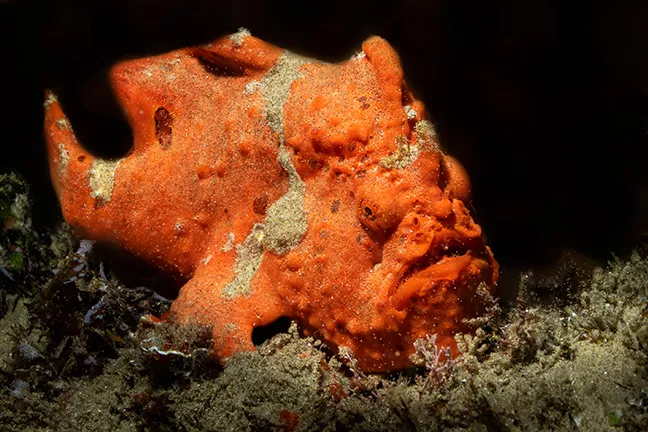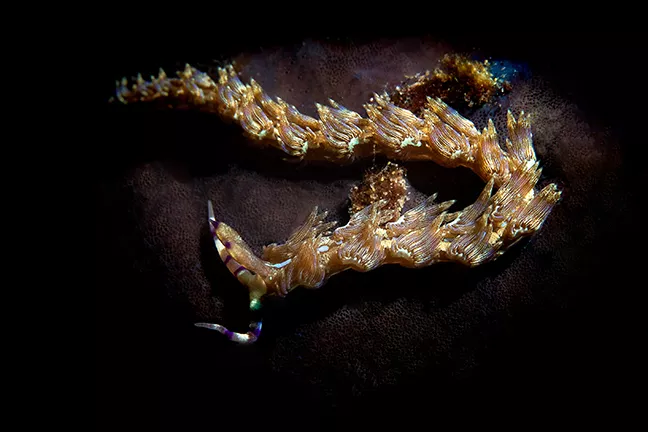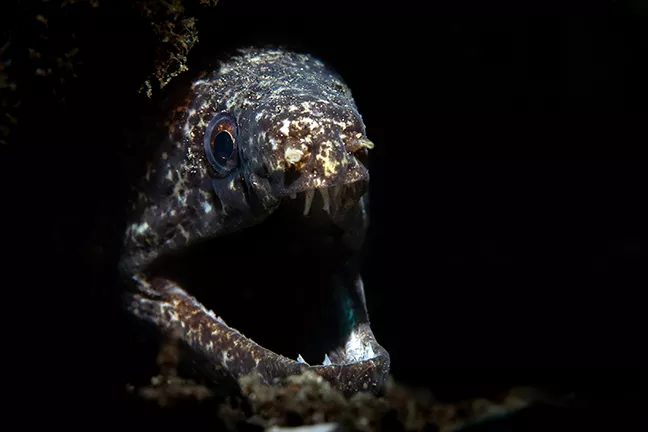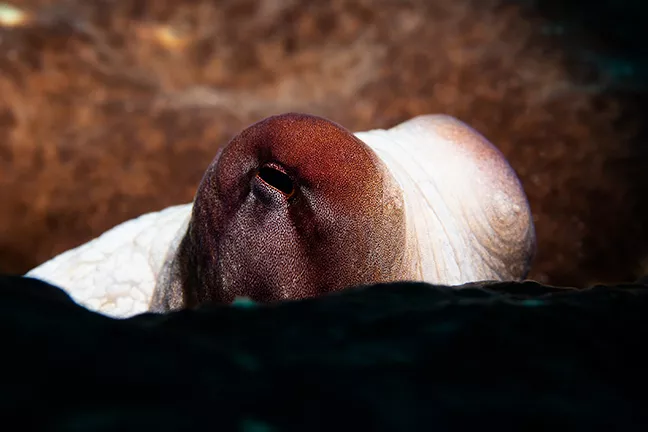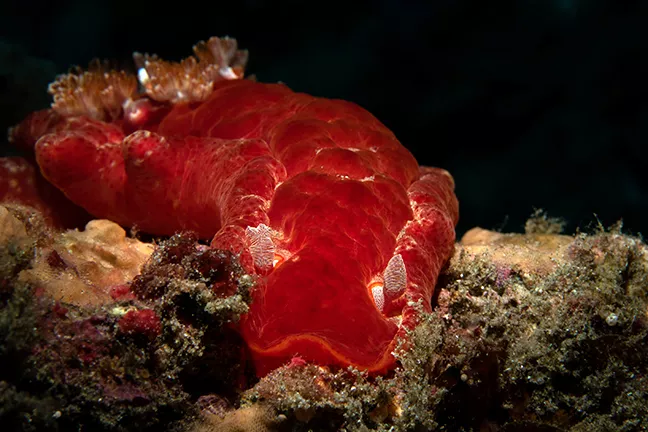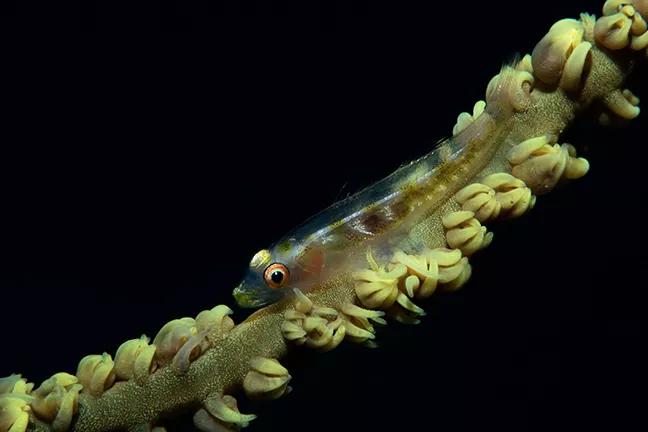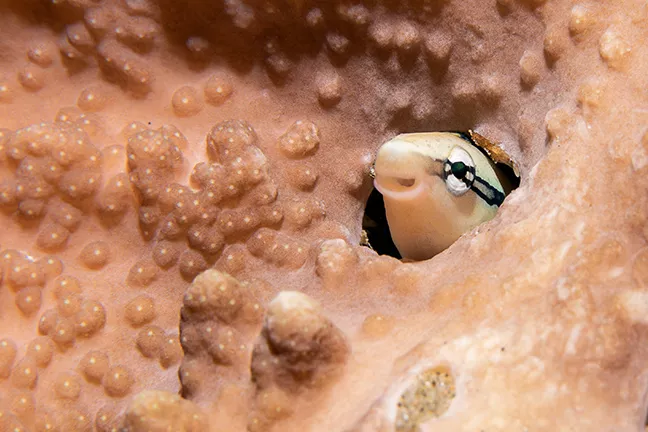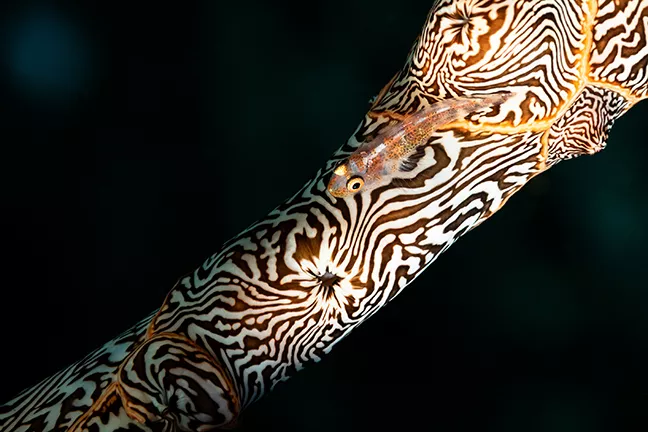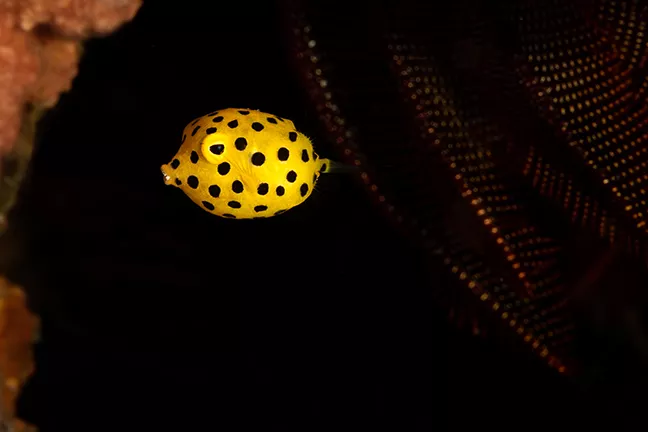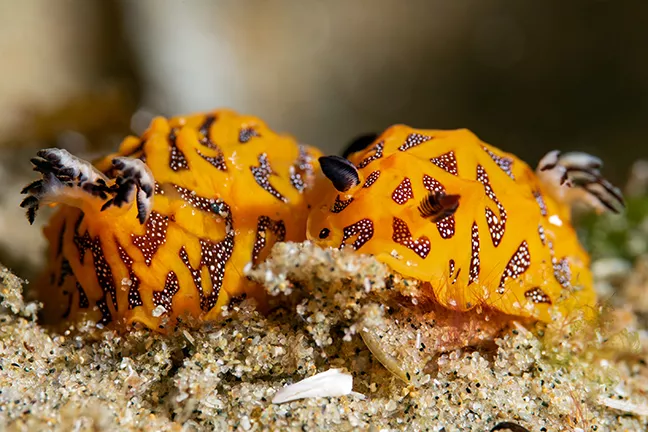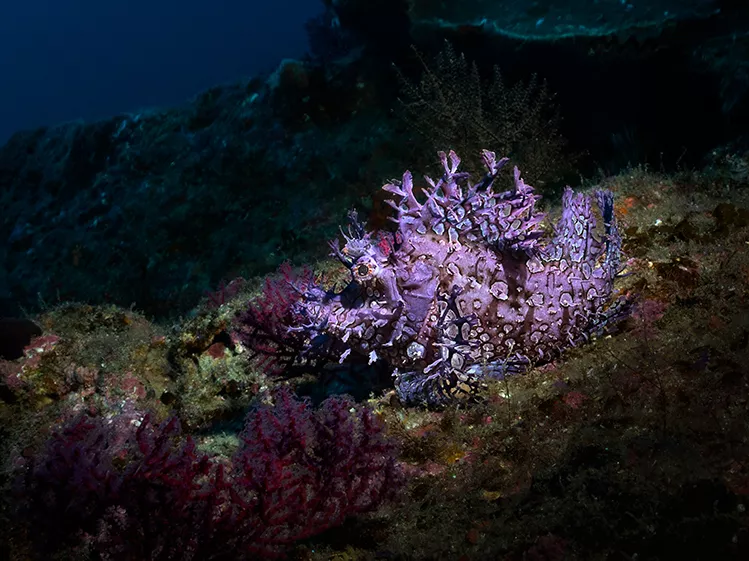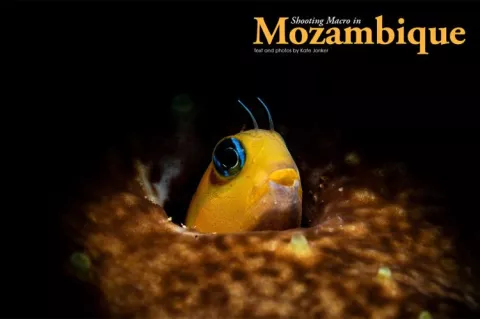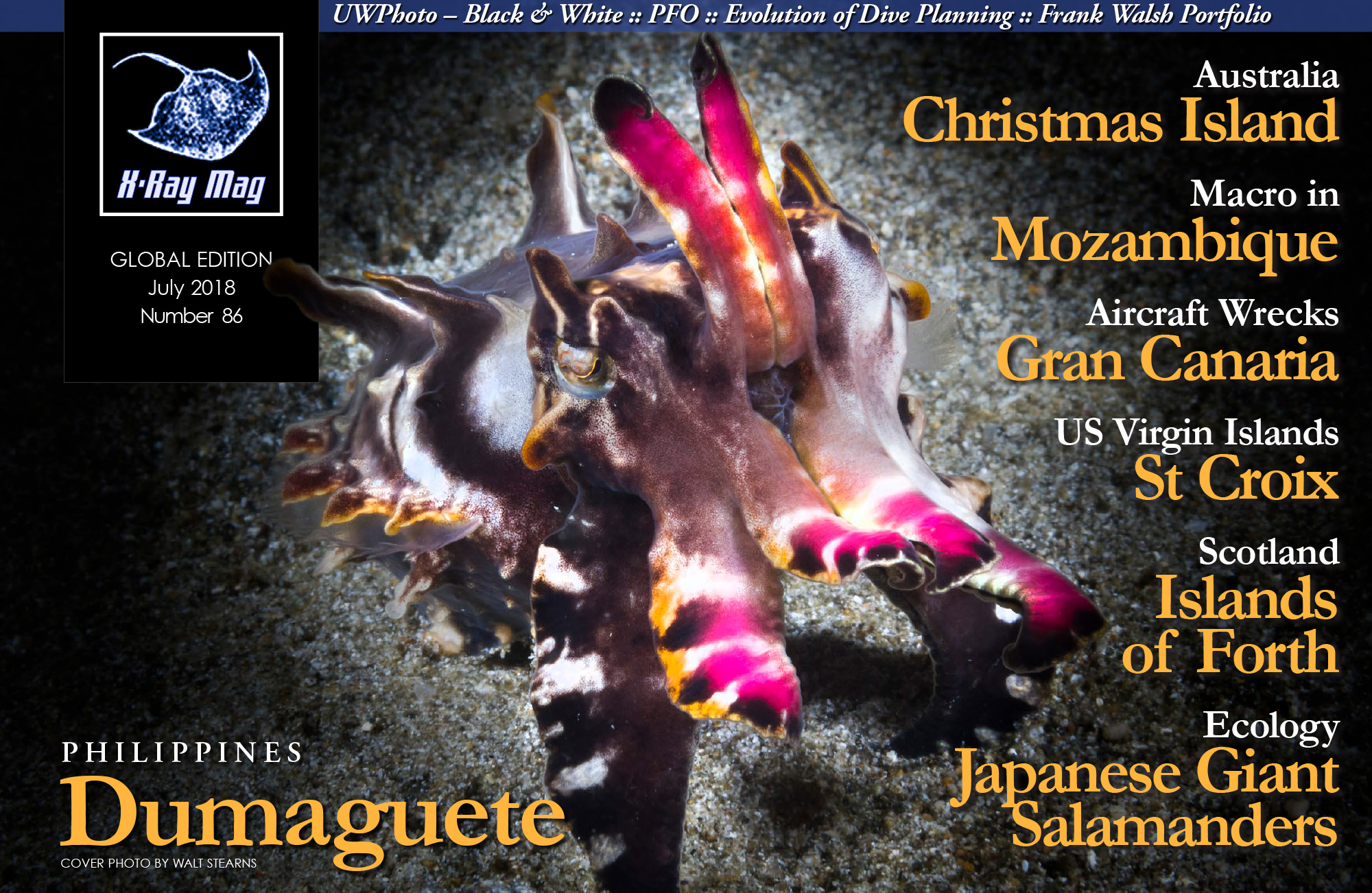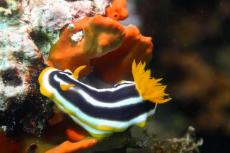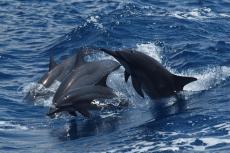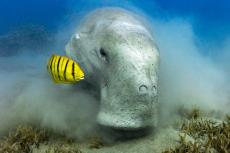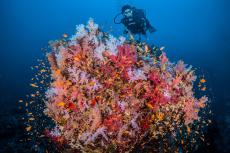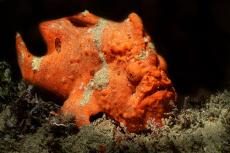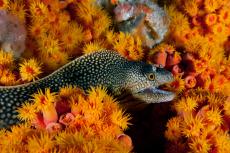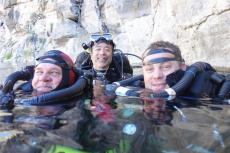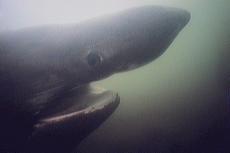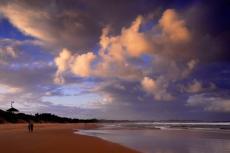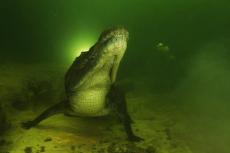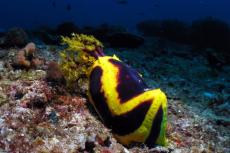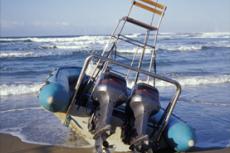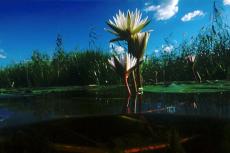There’s a cartoon that pops up on social media every now and again of a diver photographing a tiny starfish on a rock as a beautiful shark glides above him. The diver continues to concentrate on the critter as his buddies try, without success, to catch his attention. Such is the life of a macro photographer, and such was my recent experience in Mozambique.
Contributed by
I have been diving in Ponta do Ouro, a small Mozambican coastal village 10km from the South African border, since 2002 and love its laid-back atmosphere, rustic village life, long sandy beaches and warm blue ocean, just waiting to be explored. Because of the clear water, schools of colourful fish, vibrant reefs and the chance of seeing “something bigger,” I had always previously opted for wide-angle photography whilst diving here.
However, a year ago, photos of incredible macro life in Ponta do Ouro started to emerge on social media, and amongst the winners of photographic competitions. I was intrigued—I had no idea that such macro life existed in Mozambique, and I was keen to go and find it for myself.
Getting there
I travelled to Ponta do Ouro with a group of 11 diving friends, flying from Cape Town to Durban and then taking a bus to the South African-Mozambican border post at Kosi Bay. Once our passports had been stamped, we were met by Isaak, a friendly Mozambican taxi driver who took us across dunes and through coastal forests on a winding sand road to Ponta do Ouro.
We soon arrived at the house we had rented, unpacked and went in search of groceries and the delicious local “2M” beer at the nearby market. A relaxing evening was spent chatting and preparing our cameras for our dives the following day.
In Mozambique, the boats launch through the surf, directly from the beach. Typical of most dive boats in Southern Africa, they have hard hulls, inflatable pontoons and outboard motors. All dive gear is loaded onto the boat at the beach, and the divers help to push the boat around so that it is facing the waves, and a tractor then pushes the boat into the water.
As soon as the boat is floating, the skipper will jump aboard, shout “ladies up” and the ladies all heave themselves up over the pontoons and onto the boat. Not very lady-like, but a lot of fun nevertheless. Once the boat is slightly deeper in the water, the gents are called to clamber aboard. Safety rules require that everyone dons a life jacket until the boat is through the surf break. It is also vital that passengers put their feet in the foot straps on the deck and hold on tightly to the ropes tied to the pontoons as it can often be a fast and bumpy ride to get through the surf.
Diving
Doodles. Our first dive was at a lovely site called Doodles. The reefs of Ponta do Ouro comprise low-profile fossilised sand dunes covered with hard and soft corals. Dive sites range from 10m to over 40m in depth, and there is something here for everyone.
To get acclimatised to the Mozambican way of diving, I opted to use a 17–70mm macro lens behind a compact macro port. Being a zoom lens, it enables one to photograph relatively wide-angle reef scenes as well as schools of fish, fish portraits and larger critters. I soon spied critters that were too small to photograph with my set up—a Favorinus nudibranch on a rosette of Spanish dancer eggs, a tiny Spanish dancer nudibranch, a beautiful purple leaf fish and sea whip gobies. There were also larger subjects that I was able to shoot at closer range, and I was very excited to see a beautiful orange frogfish that tried to camouflage himself against a large orange sponge.
Tea Garden. Not wanting to change my lens in-between dives, I used the same setup on our next dive at Tea Garden where I spent most of my time photographing the vibrant reef fish as well as the many shrimps, porcelain crabs and anemone clownfish that shared their sprawling anemone homes. A huge red octopus sat superciliously atop the reef, looking very much like a character from the movie, Pirates of the Caribbean.
Lionfish Alley. The next day was definitely macro day. Armed with my 60mm macro lens, snoot and strobes and a +12.5 diopter to magnify the tinier critters, we went off to Lionfish Alley, a smallish reef 30 minutes up the coast from Ponta do Ouro. Critters were plentiful, and I spent a very happy 40 minutes photographing tiny blennies that played hide-and-seek with me as they darted in and out of their holes on the reef. Nudibranchs chomped their way through their food of choice, leaf fish swayed in the gentle surge, and octopuses hid in cracks on the reef.
Suddenly, all pandemonium broke out and we were enveloped in a huge school of about 300 yellow-spotted kingfish. They circled us, swarmed around us, the black spots along their bodies flashing on and off. They were in hunting mode, and the fish on the reef quickly darted for cover. This carried on for a good 15 minutes until the tornado of fish disappeared as quickly as it had appeared. What an amazing experience—and, of course, it was a photographic opportunity missed as we all had macro lenses on our cameras!
The dive continued, and we found more beautiful nudibranchs, gobies and shrimps. The fun ensued on the safety stop as a lone remora swam from diver to diver, trying to find a new home. Fortunately, no one was to his liking!
Close. Our second dive of the day was at a site called Close, but as the surge was pretty strong, I struggled to take any reasonably good macro photos. There were quite a few tiny nudibranchs, which were impossible to capture using a diopter. Small sea whip gobies kept us entertained as they darted up and down their sea whip homes, and a beautiful pale pink and purple scorpionfish lazed on the reef, sadly too big for my macro setup. It was a really beautiful site, with a very busy cleaning station, but unfortunately not a very successful macro dive for me.
Atlantis. The following day was a day I had been waiting for with mixed emotions. It was to a dive site known as Atlantis, which would take us to the limits of recreational diving. The last time I dived here, I had experienced nitrogen narcosis, and I was not keen to experience that tunnel vision and ringing in my ears again. At the same time, I was incredibly excited, as I had heard that there was a purple Rhinopias frondosa, or weedy scorpionfish, on this reef—a fish at the top of my bucket list that I had always wanted to see.
Conditions were perfect, and descending to the reef, the water was midnight blue, clear and calm with no current. The beauty of the reef quickly opened up to us, and we could see the huge, black tree coral forests that adorned the top of the reef at 36m. We only had a short time to explore the reef, and before long, we spotted a huge orange Spanish dancer, the size of a dinner plate—then another and another. Suddenly, with just three minutes left of the dive, we found him—the purple weedy scorpionfish sitting proudly on a patch of the reef, well camouflaged between a clump of purple sea fans!
I took a few photos and swam on, giving the others the opportunity to photograph this “Holy Grail” of fish. I reviewed my photos and realized that, in my excitement, I had neglected to observe the “get close and then get closer” rule of underwater photography, and the fish was very small in the frame. Once the other divers had finished, I had one more minute to take some closer shots before our bottom time was up and we had to make our slow ascent to the surface.
It had been an exhilarating dive and we all met on the surface, whooping with excitement. As we waited to climb onto the boat, we were joined by a solitary wahoo, who hung next to us, watching our antics. The excitement and adventure of exploring this incredible reef and discovering a fish that is so seldom seen in these waters was unforgettable.
Checkers. The excitement lasted long into our next dive of the day, which was at Checkers, one of my favourite sites as it has beautiful topography and is teeming with fish life. I spent the dive floating between the schools of snappers and batfish, taking wide-angle macro photos of the clown anemonefish and having a bit of a giggle at one of my buddies who insisted that a piece of coral was in fact a nudibranch. He spent much of the dive taking photos of said nudibranch, only to find out later that it was, in fact, a coral! And such is macro diving, especially for those who are in need of corrective lenses!
Stables. The following day, we dived on the moon—literally! We descended 30m to a completely flat, sandy sea floor that was seemingly barren apart from hundreds of sea pens. This was Stables, the legendary “muck diving” site of Ponta do Ouro. Visibility was incredible, and we could see in all directions as far as the blue horizon would allow. As we started to swim, life started to emerge from amongst the sea pens. Curious hairy urchins known as sea mice, shy filefish, pipefish and seahorses were discovered hiding among the sea pens, and a strange-looking eel poked its nose out from a hole in the sand. It was a silent and eerie dive that, because of its depth, was sadly over far too soon.
Three Sisters. The second dive of the day was a little more normal. We visited Three Sisters, where blennies peeked out of holes in the reef and garden eels swayed in the sand. Sea whips, covered with tiger anemones, provided a beautiful backdrop for the little gobies that had made them their homes. Nudibranchs grazed on the reef and a huge variety of reef fish of every shape, size and colour swirled around the three large rocks that give this site its name. There was quite a bit of surge and current running, so I spent most of the dive on the sheltered side of the reef photographing the nudibranchs, inquisitive geometric eels and comical blennies.
Blacks. The following day took us to one of Ponta do Ouro's most famous macro dive sites, Blacks. Here, we were treated to a multitude of macro subjects, from robust ghost pipefish, nudibranchs, juvenile fish, pipefish and the cutest, shy little yellow black-spotted boxfish that kept turning his back on me. Hinge-beak shrimps patrolled the lairs of the spiteful black-cheeked morays that waited to snap at the hands and arms of unwary divers. Although this is a relatively small reef, I could have spent hours exploring it, as there was so much to see.
All too soon, it was our last day and we opted to return to Blacks. Early into the dive, one of my buddies called me over and pointed at a bushy hydroid. As it swayed in the surge, its branches opened up to reveal a Bornella anguilla, a nudibranch I had been hoping to see for over 10 years! Photographing this beauty was a great challenge as I had to wait for the hydroid fronds to open up, focus on the nudibranch and press the shutter before they closed, hiding him from me again.
I concentrated and concentrated, desperate to get a good shot. Just then, my husband came over to me, frantically waving and showing me the sign for “shark.” He wanted me to follow him, but I didn’t want to leave my nudibranch behind until I was certain I had taken the best possible photo. I waved at him and let him swim off—this was far more important than seeing a shark that I wouldn’t be able to photograph with a macro lens.
When we surfaced, my husband asked if I had seen the shark. I replied that I had not, and he started laughing. He told me that I had had my nose so deep into the reef that I had yet again missed seeing a zebra shark, one of the very few sharks I have never seen and really wanted to, but always missed. We laughed all the way back to the beach.
Afterthoughts
Our trip to Ponta do Ouro certainly ended on a high note. It was very different to any of our previous trips, and we dived some incredible sites and explored fascinating new sites too. I feel that we have only scratched the tip of the iceberg as far as macro photography in Mozambique goes, and there is so much more to be discovered.
There are definitely some sites that are more suited to macro photography—such as Tea Garden, Blacks, Lionfish Alley and Stables—and others that are better for wide-angle. The reefs in Ponta do Ouro are teeming with life and are of such great diversity, though, that whatever setup you choose to take beneath the waves with you, you will always find exciting and beautiful subjects to photograph. But don’t be surprised if a whale shark or manta swims above you when you are photographing nudibranchs—as such is the life of a macro photographer.
Kate Jonker is an underwater photographer and writer based in South Africa. She teaches underwater photography, is an SSI Dive Control Specialist and dive boat skipper for Indigo Scuba in Gordon’s Bay and leads dive trips across the globe. For more information, please visit: Katejonker.com.

